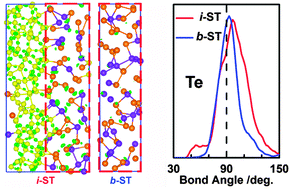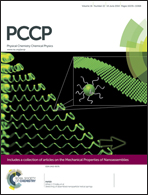Role of the nano amorphous interface in the crystallization of Sb2Te3 towards non-volatile phase change memory: insights from first principles†
Abstract
The nano amorphous interface is important as it controls the phase transition for data storage. Yet, atomic scale insights into such kinds of systems are still rare. By first-principles calculations, we obtain the atomic interface between amorphous Si and amorphous Sb2Te3, which prevails in the series of Si–Sb–Te phase change materials. This interface model reproduces the experiment-consistent phenomena, i.e. the amorphous stability of Sb2Te3, which defines the data retention in phase change memory, and is greatly enhanced by the nano interface. More importantly, this method offers a direct platform to explore the intrinsic mechanism to understand the material function: (1) by steric effects through the atomic “channel” of the amorphous interface, the arrangement of the Te network is significantly distorted and is separated from the p-orbital bond angle in the conventional phase-change material; and (2) through the electronic “channel” of the amorphous interface, high localized electrons in the form of a lone pair are “projected” to Sb2Te3 from amorphous Si by a proximity effect. These factors set an effective barrier for crystallization and improve the amorphous stability, and thus data retention. The present research and scheme sheds new light on the engineering and manipulation of other key amorphous interfaces, such as Si3N4/Ge2Sb2Te5 and C/Sb2Te3, through first-principles calculations towards non-volatile phase change memory.


 Please wait while we load your content...
Please wait while we load your content...